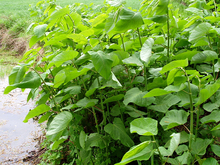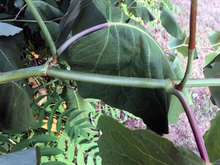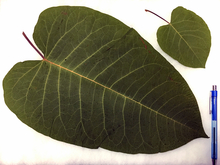Quick facts
Giant knotweed is an invasive species.
- Giant knotweed grows in disturbed areas and can tolerate varying sun availability.
- It is the largest of the knotweeds.
- Its growth shades out and displaces native vegetation.
Giant knotweed should be reported. The Minnesota Department of Natural Resources provides detailed recommendations for reporting invasive species.
How to identify giant knotweed
- Giant knotweed (Polygonum sachalinense) is a perennial shrub that can grow nine to twenty feet in height, typically with no branches.
- Resembles bamboo.
Stem
- Large, light green and hollow with reddish joints.
Leaves
- Simple, alternate, toothless and heart shaped.
- They are large, reaching twelve inches across and six to fourteen inches wide.
- Tips of leaves are blunt.
Flowers
- Small, off-white or greenish flowers are compact, usually shorter than the leaves.
- They form in clusters and bloom up from the leaf axil from July to October.
- Giant knotweed has perfect flowers, including both female and male fertile flowers.
Seeds
- Female flowers produce a winged papery fruit.
- Each fruit contains a small, shiny, brown-black three-sided viable seed.
Roots
- The root system extends deep into the soil and has thick mats of rhizomes.
- Reproduction primarily occurs through these rhizomes.
Reviewed in 2019




